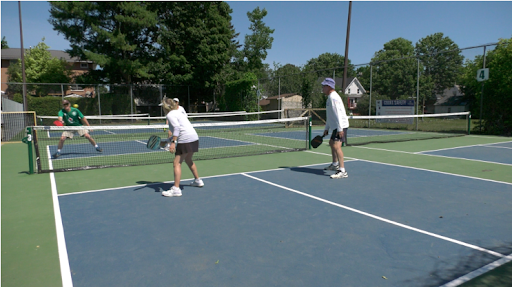There is a basic skill that often goes overlooked or undetected and that is the ready position. Many people perceive that the “ready position” is all about the paddle being “up”.
While it’s true that the paddle needs to be up and ready, the lower half of the body is what allows a player to move fluently around the court.
To maintain an all-around ready position be sure to include the split step; this technique is simple, yet fundamental, and definitely an essential component of playing good pickleball.

Photo credit: CTV News Ottawa
Have you taken a pickleball lesson at any point in your pickleball journey and learned a version of the ready position, paddle positioning, and proper footwork?
Admittedly, it wasn’t until I started seeing videos of myself on the court when I finally understood just how often my paddle would fall by my side.
I thought I was ready but even though I may have been tracking the ball with my eyes, the paddle dropping to the side meant I was moving less efficiently and I could see that I was standing flat-footed, which made me slower as well.
Once I realized what I was doing, it was a matter of overcoming a bad habit and I had to put in some work and self-discipline to correct what I was instinctually doing. Correcting a bad habit is easier said than done for most people, but doable. It takes time, practice, and repetition.
From the waist down, it’s all about the feet. When you observe a person split-stepping you’ll notice the following things:
- They are split-stepping after making their shot or just before the opponent hits theirs
- They are barely lifting their feet off the ground when they split
- There is no hopping, it’s a blend of a shuffle and slide
- During repetitive rallies, a player who incorporates a split step will catch a rhythm, especially when playing up at the net and engaging in long dinking rallies
- Their paddle is up by their navel or lower chest area, not down by their waist
-1.jpg?upscale=true&width=1024&upscale=true&name=unnamed%20(3)-1.jpg)
Photo credit: Sara McInnes
From the waist up, yes, having your paddle ready is incredibly essential in keeping a rally going during practice or when trying to win a rally during a game.
By keeping the paddle in the middle of the body and not leaning it heavily on the forehand or backhand side you are protecting as much area as possible. When exposing one side, you leave it open for your opponents to hit.
Pretty straightforward stuff, however, if you start allowing your paddle to lean one way or drop, before you know it you’ve likely developed a bad habit.
If you find yourself the receiver of multiple body shots or are unable to return a snappy volley from the other team, chances are you are not in a neutral ready position.
Read in the Un-ready Position
There’s nothing like “baiting” a player to attack the ball. This can be done by intentionally feeding a higher bouncing ball (for the opponent to attack) or by holding the paddle low, lower than the height of the net, tempting the opponent to strike with an attack.
There is one pro player who comes to mind JW Johnson who definitely has a lower ready position, his legs are fully engaged, knees bent and paddle sits down.
For those of you who can’t picture JW’s style of play, it’s worth taking a look on YouTube, his hands are incredibly fast and so although his paddle looks like it’s “dropped” it’s not and he is very much ready to engage in a hands battle.
-Oct-06-2022-11-33-51-89-PM.png?upscale=true&width=492&upscale=true&name=unnamed%20(1)-Oct-06-2022-11-33-51-89-PM.png)
Photo credit: reddit
Transition Zone
Hopefully, no one has told you to run to the net as fast as possible. The idea is to make your way to the net from the baseline with control. When your team is serving this will often take a few shots - and split steps - before establishing yourself at the non-volley zone. Split stepping as you make your way up the court sets you up to receive any shot the other team throws your way. It keeps you maneuverable and light on your feet.
-1.jpg?upscale=true&width=808&upscale=true&name=unnamed%20(4)-1.jpg)
If you are finding yourself standing flat-footed and feeling rooted to the ground, consider adding in some footwork drills into your practices to increase agility; and really focus on exploding off of one foot to take you in a certain direction.
If you’re working with a coach, chances are you are already incorporating footwork drills. Off of the court, skipping is a great way to keep the weight of the body on the balls of the feet, because who skips on the heels of their feet?
This article was taken from our 'Control the Kitchen' Newsletter, if you're interested in receiving more content like this, please feel free to sign up using the subscribe section located at the bottom left of this page (or underneath the article if you're on mobile), thanks!